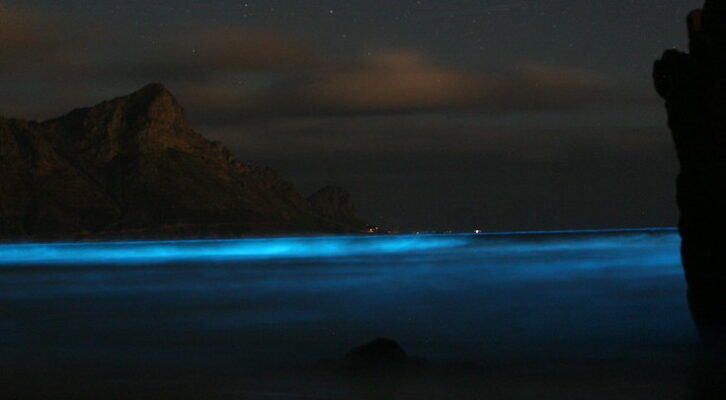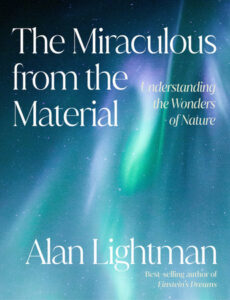
Oceans That Glow: On the Timeless Beauty of Bioluminescence
Alan Lightman Considers the Power and Benefits of Natural Deep Sea Light
Some years ago I was returning to my island house in Maine, under a dark night sky, and I noticed that the wake of the boat was glowing. As far as I could tell, it was bluish in color. That was my first experience with bioluminescence. Later, I discovered that I could create that same oceanic glow simply by waving a stick or paddle in the water. Bioluminescence—the glow produced by fireflies, algae, and a few other organisms—is a beautiful and eerie phenomenon. It’s the natural light of our terrestrial world. No human-made candles or flashlights or batteries needed.
In December 1833, writing in his journal aboard the Beagle, Darwin described bioluminescence (which he called “phosphorescence of the sea”):
While sailing in these latitudes on one very dark night, the sea presented a wonderful and most beautiful spectacle. There was a fresh breeze, and every part of the surface, which during the day is seen as foam, now glowed with a pale light. The vessel drove before her bows two billows of liquid phosphorus, and in her wake she was followed by a milky train.
One of the first known descriptions of the phenomenon was by Aristotle (384 BC–322 BC) in his book De anima (On the Soul), where he writes that “some objects of sight which in light are invisible, in darkness stimulate the sense; that is things that appear fiery or shining.”
As described in the essay “Fireflies,” bioluminescence is caused by a chemical reaction. An organic molecule called luciferin produces energy when combined with oxygen. That energy is temporarily stored in another molecule called adenosine triphosphate, which is found in all living organisms. Essentially, the electrons in the atoms of adenosine triphosphate and the oxidized luciferin move to lower energy levels and release that energy differential in the form of light. In a similar manner, wood reacting with oxygen (in a fire) produces light. But unlike fire, which produces heat as well as light, the chemical reactions in bioluminescence produce a “cold fire.” Light but no heat. The process is extremely efficient and converts nearly 100 percent of the chemical energy into light. Bioluminescence can come in a range of colors, depending on the type of luciferin. Squids, for example, are able to produce multiple colors.
Bioluminescence, like most all distinctive traits, evolved to attract mates, defend against predators, and aid in the hunt for food.
The bioluminescence that comes from stirring up the ocean is produced mostly by algae and plankton. Fascinating members of this group are the microscopic, single-celled organisms known as dinoflagellates. Like plants, they take in carbon dioxide and release oxygen. Dinoflagellates are at the bottom of the oceanic food chain. They’re eaten by copepods, miniature versions of shrimp. Bigger fish eat copepods, and so on, until we’re up to the great white shark. Dinoflagellates swim about by waving tiny hairs, the flagella or cilia. (See the essay “Paramecia” for more on cilia.)
Why do these organisms produce light when disturbed? Such activity costs energy, and they wouldn’t expend the energy without a good reason. In evolutionary terms, there must be some survival benefit to bioluminescence. Biologists believe that bioluminescence, like most all distinctive traits, evolved to attract mates, defend against predators, and aid in the hunt for food.
Recent research by biologist Andrew Prevett of the University of Gothenburg, Sweden, and his colleagues suggests several survival benefits of bioluminescence for dinoflagellates in particular—all to protect the organisms against their major predators, the copepods. First, the flash acts as a warning and notifies the preying copepods that the dinoflagellates are toxic. (Indeed, they contain saxitoxin and its derivatives.) The association of visual warning signals with toxicity and their use as a survival strategy is found in a number of other animals, such as poison dart frogs.
If your predator doesn’t identify you for what you are, then it may eat you before it realizes you are poisonous. Second, the flash can startle would-be assassins, allowing time for the dinoflagellate to escape. Squids and certain other fish use the same tactic. For dinoflagellates, the flash also serves as an advertisement to larger fish, who then swim to the feast and dine on the copepods, while the dinoflagellates move to safer territory.
It’s astonishing that a single-celled organism can evolve such effective defense mechanisms and strategies. That development, acting through the long and dark hallways of evolution, clearly shows that natural selection is a purely mechanical process. No intelligence is required. No brain is required. All that’s needed are random genetic mutations, many caused by copying errors in gene duplication.
A small fraction of those mutations produce traits that have survival benefit. By and large, organisms without those beneficial traits die off before reproducing when faced with a difficult environment. Organisms with those traits live to pass on their modified genes. It’s a simple but profound idea. And it’s all mindless, just as the beautiful phenomenon of bioluminescence emerges without plan or design.
__________________________________

Excerpted from The Miraculous from the Material: Understanding the Wonders of Nature by Alan Lightman. Reprinted by permission of Pantheon Books, an imprint of the Knopf Doubleday Publishing Group, a division of Penguin Random House LLC. Copyright © 2024 by Alan Lightman.
Alan Lightman
Alan Lightman earned his PhD in physics from the California Institute of Technology and is the author of seven novels, including the international best seller Einstein’s Dreams and The Diagnosis, a finalist for the National Book Award. His nonfiction includes The Accidental Universe, Searching for Stars on an Island in Maine, and Probable Impossibilities. He has taught at Harvard and at MIT, where he was the first person to receive a dual faculty appointment in science and the humanities. He is currently a professor of the practice of the humanities at MIT. He is the host of the public television series Searching: Our Quest for Meaning in the Age of Science.



















